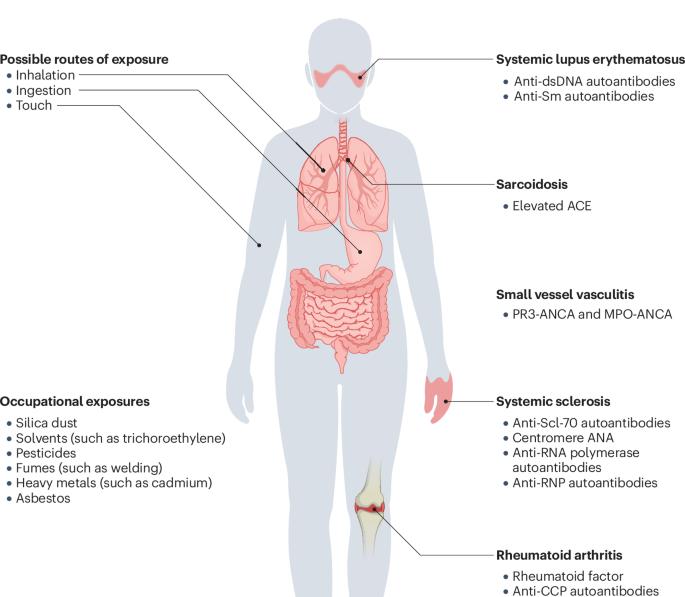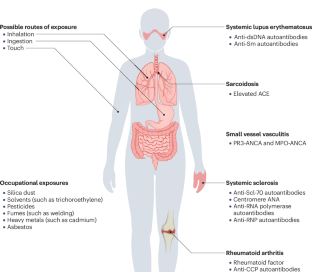职业性粉尘和化学物质暴露与自身免疫性风湿病的发展
IF 32.7
1区 医学
Q1 RHEUMATOLOGY
引用次数: 0
摘要
虽然早在一个多世纪前,人们就已经开始描述某些职业暴露与自身免疫性风湿病的发生之间的关联,但这种关联只是在过去 10 年中才被更广泛地认识到,因为在建筑和房屋装修中使用了高二氧化硅含量的人造石材。现在,越来越多的大量证据表明,无论是通过采矿、石匠、建筑还是其他行业接触职业性粉尘和化学物质,都会增加罹患包括类风湿性关节炎和系统性硬化症在内的各种系统性自身免疫性风湿病(SARDs)的风险。虽然二氧化硅诱发自身免疫的致病机制尚未完全阐明,但人们认为肺泡巨噬细胞摄入二氧化硅以及随之而来的吞噬体损伤是一个起始事件,最终导致自身抗体的产生和免疫介导的组织损伤。与矽尘相比,人们较少认识到职业性接触有机溶剂等化学品与 SARDs 风险增加之间存在所谓的因果关系,对其免疫发病机制也不甚了解。认识到职业性粉尘和化学品暴露在 SARDs 发病中的重要性对工作场所健康和安全法规具有重要意义,同时也为更好地了解自身免疫性疾病的发病机制和实施预防策略提供了一个独特的机会。本文章由计算机程序翻译,如有差异,请以英文原文为准。


Occupational dust and chemical exposures and the development of autoimmune rheumatic diseases
Although the association between certain occupational exposures and the development of autoimmune rheumatic disease was first described over a century ago, this association has only become more widely recognized in the past 10 years because of the use of high-silica-content engineered stone in construction and home renovation. There is now a substantial and growing body of evidence that occupational dust and chemical exposure, be it through mining, stonemasonry, building or other trades, increases the risk of various systemic autoimmune rheumatic diseases (SARDs) including rheumatoid arthritis and systemic sclerosis. Although the pathogenic mechanisms of silica-induced autoimmunity are not fully elucidated, it is thought that alveolar macrophage ingestion of silica and the ensuing phagosomal damage is an initiating event that ultimately leads to production of autoantibodies and immune-mediated tissue injury. The purportedly causal association between occupational exposure to chemicals, such as organic solvents, and an increased risk of SARDs is less frequently recognized compared with silica dust, and its immunopathogenesis is less well understood. An appreciation of the importance of occupational dust and chemical exposures in the development of SARDs has implications for workplace health and safety regulations and offers a unique opportunity to better understand autoimmune disease pathogenesis and implement preventative strategies. This Review discusses the current evidence for the association between occupational exposures, particularly silica dust and solvents, and the risk of developing systemic autoimmune rheumatic diseases. The authors emphasize the importance of considering occupational history in the rheumatology clinic.
求助全文
通过发布文献求助,成功后即可免费获取论文全文。
去求助
来源期刊

Nature Reviews Rheumatology
医学-风湿病学
CiteScore
29.90
自引率
0.90%
发文量
137
审稿时长
6-12 weeks
期刊介绍:
Nature Reviews Rheumatology is part of the Nature Reviews portfolio of journals. The journal scope covers the entire spectrum of rheumatology research. We ensure that our articles are accessible to the widest possible audience.
 求助内容:
求助内容: 应助结果提醒方式:
应助结果提醒方式:


